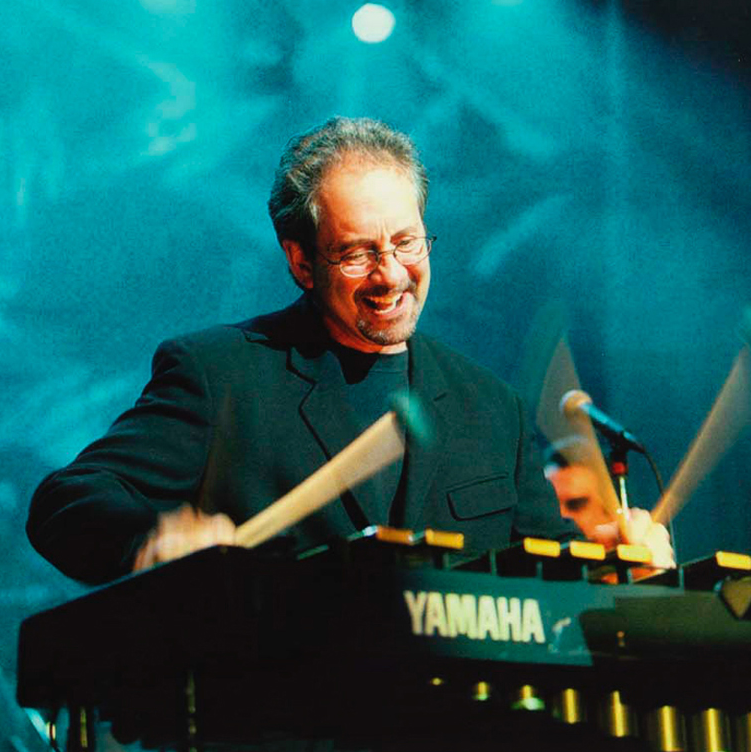Remaining in the Fold

Dave Samuels
“Piano and drums are both percussion instruments,” Samuels says. “The intersection was the vibes. Since all three instruments are in the percussion family, I never really left the fold.” The early training Samuels received equipped him to read very well but provided few opportunities to learn about improvisation.
“I learned to improvise the way most of the earlier jazz artists did,” Samuels recalls. “I learned what I could and then just went out and played. Today we have a very organized system taught here at Berklee, but before Berklee or other music schools from any era, people learned by apprenticing. Although I took some music courses in college, I basically learned by listening, transcribing, and asking other musicians about what they were doing.”
Chicago has a vibrant jazz scene, and a lot of great musicians—Cannonball Adderley, Sonny Stitt, Tony Williams, Herbie Hancock, and Charles Lloyd among them—paid visits to the high school Samuels attended when they played in Chicago. “For us, it was the equivalent of being into basketball and having Michael Jordan come to play a pickup game with you,” he says. “These were unbelievable moments. So many musicians were willing to visit and talk. There wasn’t any money in it for them, it was just part of their crusade to pass the music on to the younger generation.”
It was a musical mentor a few years his senior that ultimately stimulated Samuels’s interest in the vibes. “A guy named Renick Ross got me started as a vibes player,” Samuels says. “He asked me to play in his group with vibes, piano, bass, and voice—no drums. At the time, I wasn’t sure what direction I wanted to go in, so I decided to try it. We only played a few concerts in a three-year period; the important thing was that we rehearsed three or four times a week. I spent a lot of my free time trying to learn the parts he was writing for four mallets.”
When it came time for college, Samuels chose not to major in music. “I started out at Roosevelt University and took only a few music courses there at Chicago Music College,” Samuels says. “I didn’t major in music because you couldn’t concentrate on vibes. You could study orchestral percussion, which included the vibes, but I had no interest in becoming an orchestral percussionist. I transferred from Roosevelt to Boston University, where I got my degree in psychology.”
After graduating, Samuels taught at Berklee between 1972 and 1974 (he rejoined the faculty in 1995). Through Berklee, he met the late drummer and vibist Alan Dawson, who helped him connect for his first high-profile jazz gig. “In 1974 I was just moving from Boston to New York when Alan Dawson referred me to [baritone saxophonist] Gerry Mulligan,” Samuels says. “Dawson had worked with Mulligan and recommended me when Gerry told him he needed a percussionist. Gerry wanted someone to play more percussion than vibes, but after I started working with him, I played less and less percussion and more vibes. I worked with him for four or five years. It was great to play next to Gerry each night. He was part of jazz history.”
Simultaneously, Samuels pursued his own interests, cofounding the groups Double Image, Gallery, and the Skylight Trio. It was his work with Spyro Gyra, however, that would bring him mainstream exposure. “I was playing in Buffalo, New York, in 1977 when a couple of the guys from Spyro Gyra came up and asked me to play on their record,” Samuels says. “I played some marimba and some vibes solos on their Morning Dance album. Soon afterwards I was hearing the title song on the radio, at the airport, everywhere. They called me to play on their next record, and in 1982, I started playing live with them.” That stint continued until 1994.
In addition to making 20 albums with Spyro Gyra, Samuels issued several recordings as a leader for the MCA, GRP, and Verve labels throughout the 1980s and 1990s and in 1993 founded his Caribbean Jazz Project (CJP). The original CJP lineup featured steel drum player Andy Narell, saxophonist Paquito D’Rivera, pianist Dario Eskenazi ’88, and Berklee faculty members Oscar Stagnaro (bass) and Mark Walker (drums). Changes in personnel and instrumentation have enabled Samuels to explore a number of Caribbean-influenced styles through CJP with such bandmates as Steve Khan (guitar), Dave Valentin (flute), Ray Vega (trumpet), Dafnis Prieto (percussion), and Ruben Roderiguez (bass).
“This group will always be changing and evolving with the music and personnel,” says Samuels. “The scope of the music we can play is pretty large and comes from the base of the tree of music from the Caribbean. The branches went north and south, and there is a tremendous amount of music connected to that tree. It’s an endless study.”
CJP struck a nerve with their 2002 recording The Gathering, which earned a Grammy as Best Latin Jazz Album. “It was a great honor to win,” said Samuels, “but I can’t say I know why it was chosen. I think it’s a great record, but there were a lot of other good records out then too. Saying I knew why it won might imply that I could do it again with the next record. You have to keep it all in perspective and continue making the best recorded music you can. If you win a Grammy, it’s fantastic; if you don’t, it doesn’t negate the value of what you’ve done.”




